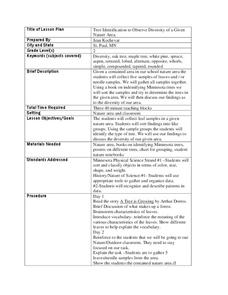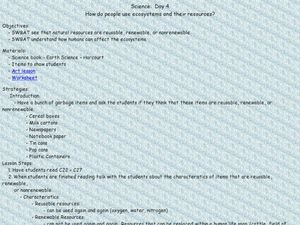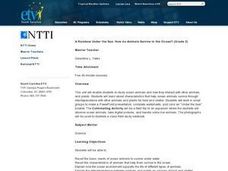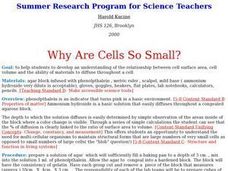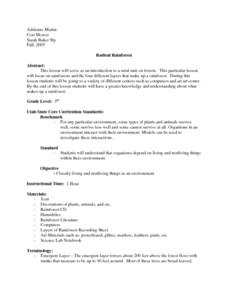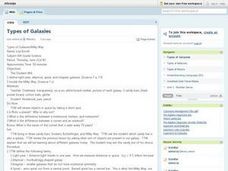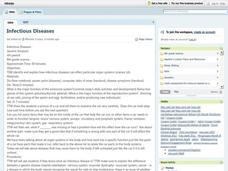Curated OER
Tree Identification to Observe Diversity of a Given Nature Area
For this tree identification lesson, 2nd graders read A Tree is Growing, discuss what makes up a forest, brainstorm characteristics of leaves, gather samples of leaves and examine their samples. Students will sort leaves and compare them...
Curated OER
Ice Core Clues
Students create a PowerPoint presentation on the information they research about the ice cores and what they tell us about Earth's past. In this ice core lesson plan, students research radioactivity, air pollution, sodium, snowfall...
Curated OER
How do people use ecosystems and their resources?
Students examine how natural resources are reusable, renewable or nonrenewable. In this ecosystems lesson students see the effects humans have on ecosystems and complete an art lesson activity.
Curated OER
Forces of Change
Second graders discuss various ways in which landforms change over time. They, in groups, research and create a reference book about landform change including tsunamis, earthquakes, weathering, erosion and volcanic eruptions.
Curated OER
Destination Outer Space
Fourth graders use effective writing skills, their imagination, and their knowledge of the nine planets as they create travel pamphlets of the solar system.
Curated OER
Cell-a-bration
Fifth graders study the structures of a plant cell and animal cell. They create a graphic organizer and a food model. Finally, they write an essay comparing and contrasting plant and animal cells.
Curated OER
A Rainbow Under the Sea: How do Animals Survive in the Ocean?
Second graders read books, watch videos, complete worksheets and participate in class discussions about ocean animals. They, in groups, design PowerPoint presentations on selected marine animals.
Curated OER
Why Are Cells So Small?
Students examine the relationship between cell surface area and the ability of materials to diffuse through a cell. They participate in an experiment in which they determine which materials diffuse easier than others. They complete...
Curated OER
Observing and Recording Biological Data
Learners create their own definition of life. They identify the eight characteristics of life in organisms. They compare and contrast the characteristics of living and nonliving things.
Curated OER
Biotic vs. Abiotic Factors
Learners share their prior knowledge of the elements of the environment. In groups, they are introduced to the concepts of biotic and abiotic factors in a specific environment. They discover their effects on organisms living in the...
Curated OER
Constant Craving
Students experience the effect of sensory stimulation through a guided visualization. They explore possible genetic relationships between drug addiction and the nervous system by reading and discussing, "Genetic Studies Promise a Path to...
Curated OER
The Phases of the Moon
Students observe the questions, "Why do we say there is a man on the moon?, What do you think of when you hear "the moon is made of cheese"?, What is meant, to you, by the expression "Once in a blue moon"? and a comic of Snoopy typing,...
Curated OER
Solution Concentration
Students determine differences in concentrations. They have to state the problem they feel exists, consider possible solutions, and develop a plan to come up with for containers whose labels have fallen off. Students base this off the...
Curated OER
The Structure of DNA
Students will demonstrate knowledge of the structure of DNA by constructing simple models of DNA with materials given to them in class. They will also discover that some female scientists such as Rosalind Franklin have not been given...
Curated OER
Radical Rainforest
Third graders examine rainforests and the four different layers that make up a rainforest. They create an advertisement poster advertising a trip to the rainforest, including information concerning why people should visit, as well as,...
Curated OER
Salinity in Mill Creek
Fifth graders use water samples collected at three different locations of Utah's Mill Creek to test salinity of water, hypothesize about salinity levels at each location, record results, and discuss their findings with classmates. ...
Curated OER
Life Cycle Of Stars
Students investigate the concept of stars and how they go through a life cycle. They take part in class discussion with the help of dialogue provided in the lesson plan. Students also view a powerpoint presentation for visual learners.
Curated OER
Types of Galaxies
Eighth graders take a quiz to review the different objects in space. As a class, they define terms related to galaxies. In groups, they make a model of the Milky Way galaxy using materials provided to them by their teacher. To end the...
Curated OER
Infectious Diseases
Eighth graders identify and explain how infectious diseases effect organ systems. Using an analogy with automobiles and body systems, they discover how one part influences the operation of the whole. Students write paragraphs about...
Curated OER
Objects in the Solar System
Eighth graders define a planet by the orbit around the sun, have a large enough gravitational force to hold a sphere shape and needs to clear the neighboorhood of it own orbital zone. They describe comets, meteoroids, meteor, meteorites...
Curated OER
The Life Cycle of a Frog
Learners read a book about a frog and the stages of its life. They read the description cards given and work in groups to study all of the wells of the frog life cycle. Finally, students identify and interpret various slides and...
Curated OER
Layers Upon Layers
Students model how layers of sediments are deposited. They use logic to derive rules or laws that can be used to examine layers of sediment in a cup and apply it to the real world.
Curated OER
Diffusion
Students are asked how does odors move around without energy? They relate concentration gradients, diffusion, and equilbrium and predict water movement into and out of cells. Students are shown a demonstration where the teacher sprays...
Curated OER
Water Awareness Portfolio Instructions
Learners participate in a water awareness portfolio. In this water conservation lesson students create a portfolio to help make them aware of current water conditions.


